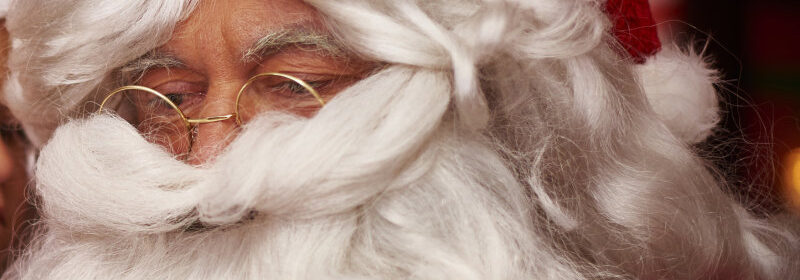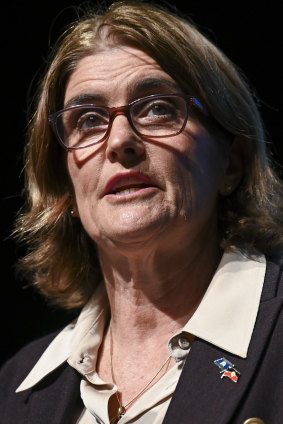Why the Reserve Bank’s wishes might land it on the naughty list

Save articles for later
Add articles to your saved list and come back to them any time.
One quarter of anaemic growth won’t worry the Reserve Bank: in fact, it’s probably what governor Michele Bullock and her little helpers put on their wishlist to Santa this year.
But over the past year, there’s no doubt regarding the direction the economy has been heading (hint: not the North Pole) and there may be a little less Christmas cheer than we might have liked.
ILLUSTRATION TO COME
Just under 24 hours after the Reserve Bank made the call to pause interest rates, reducing their Grinch-factor among mortgage holders, their helpful elf on the shelf – the Australian Bureau of Statistics – reported how we behaved in the three months to September.
According to the Bureau’s “national accounts”, our real gross domestic product – the value of the economy’s production of goods and services – rose 0.2 per cent in the three months to the end of September.
That might sound OK: it brought economic growth across the year to a slow but positive 2.1 per cent. However, momentum has slowed and a lot of that growth reflected stronger numbers earlier in the year.
The measure that really matters, economic growth per person, slid faster in the September quarter than in the previous four, dropping 0.5 per cent. That’s how you know our growth hasn’t translated to better living standards for most people.
Wishlist: A slowing economy, please. Credit: iStock
We can thank our growing population, mostly driven by increased immigration, for masking the economic slowdown. Having a bigger workforce generally means we will produce more, even if we’re producing a bit less on an individual level.
That doesn’t mean we can’t pat ourselves on the back. We worked fewer hours than we did last quarter, yet became more productive.
We can’t get too excited about that because it’s only one quarter of improvement after four of decline, but our productivity growth – measured by GDP for every hour worked – is now back in positive territory at 0.9 per cent.
Reserve Bank governor Michele Bullock says the Reserve Bank will ‘do what is necessary’ to reduce inflation.Credit: Martin Ollman
Wages have also picked up. Compensation of employees rose 2.6 per cent in the September quarter and 8.4 per cent over the year, partly because of the Fair Work Commission’s decision to raise minimum wages, but also because businesses offered higher wages and bonuses to attract skilled workers.
Since productivity growth makes it easier for companies to offset rising costs – including those wage rises – it’s a key factor in keeping a lid on inflation and one which the Reserve Bank has cited repeatedly as its prescription against high price rises.
But the bank will need to see more than a temporary uptick in productivity to feel assured. Inflation in the September quarter continued creeping up by 1.2 per cent, driven by petrol, rent and electricity prices.
While productivity and wages have ticked up, the data also showed household savings being erased.
As expected, growing mortgage payments (from rising interest rates) have hit hip pockets, and savings have continued to drop relative to income. The household savings ratio is at the lowest it’s been since the December quarter of 2007: the start of the global financial crisis.
The ending of the low and middle income tax offset across the past two years took a bite out of pay packets. But all those savings households built up across the pandemic while receiving stimulus and being locked away from shops have gradually been whittled away as prices continue to rise.
The Reserve Bank wants to rein back spending in the economy to soften growth and inflation, but it’s approaching a fine line between that and dipping into a recession.
That’s despite many households cutting back spending. Consumer spending growth per person was negative and overall consumer spending growth came to a standstill in the September quarter, turning negative in states such as South Australia, Western Australia and Tasmania.
Consumption matters a lot because it’s the biggest slice when calculating the size of the Christmas cake that is our economy. AMP chief economist Shane Oliver says the fact consumer spending growth slowed to zero in the September quarter casts a cloud over future growth, especially as interest rates continue to work their way through household budgets and the economy.
Government spending, growing 1.1 per cent, contributed to some of the slowdown in consumer spending. Without public spending, economic growth over the quarter would have slowed to zero. The government’s electricity rebates and expansion of the childcare subsidy scheme meant while the public sector increased spending, it reduced some household expenses.
The Reserve Bank wants to rein back spending in the economy to soften growth and inflation, but it’s approaching a fine line between that and dipping into a recession. While growth over the year was above the Reserve Bank’s forecast, another quarter of 0.2 per cent growth would drag the annual rate from 2.1 per cent to about 1.3 per cent.
There are three finer details which also give us pointers on how different areas of the economy are tracking.
Despite the not-too-merry sentiment among consumers, businesses were a little more optimistic with private investment increasing 1.2 per cent.
There are also still some pressure points in the construction industry. Renovation activity finally increased after seven quarters of decline, helped by an easing in supply chain issues, but other residential dwelling construction fell, leaving the building backlog high.
Looking outwards to trade, a downturn in our biggest trading partner weighed on demand for our major exports including coal (kids must be behaving themselves), gas and iron ore. The fall in mining exports in particular meant we stacked up about $2.4 billion worth of inventories. It was partly offset by international travellers swinging by for the Women’s World Cup and growth in international students.
On the other side of the equation, Australians gave Santa a run for his frequent flyer points, growing imports (more than exports) including a nearly 20 per cent increase in travel services.
The pick-up in productivity and confirmation of a crawling economy might be welcome gifts if they guide inflation lower. But with the full weight of past rate rises yet to flow through, the jury’s still out on whether the Reserve Bank will be on the naughty or nice list this year.
Ross Gittins is on leave.
The Business Briefing newsletter delivers major stories, exclusive coverage and expert opinion. Sign up to get it every weekday morning.
Most Viewed in Business
From our partners
Source: Read Full Article


